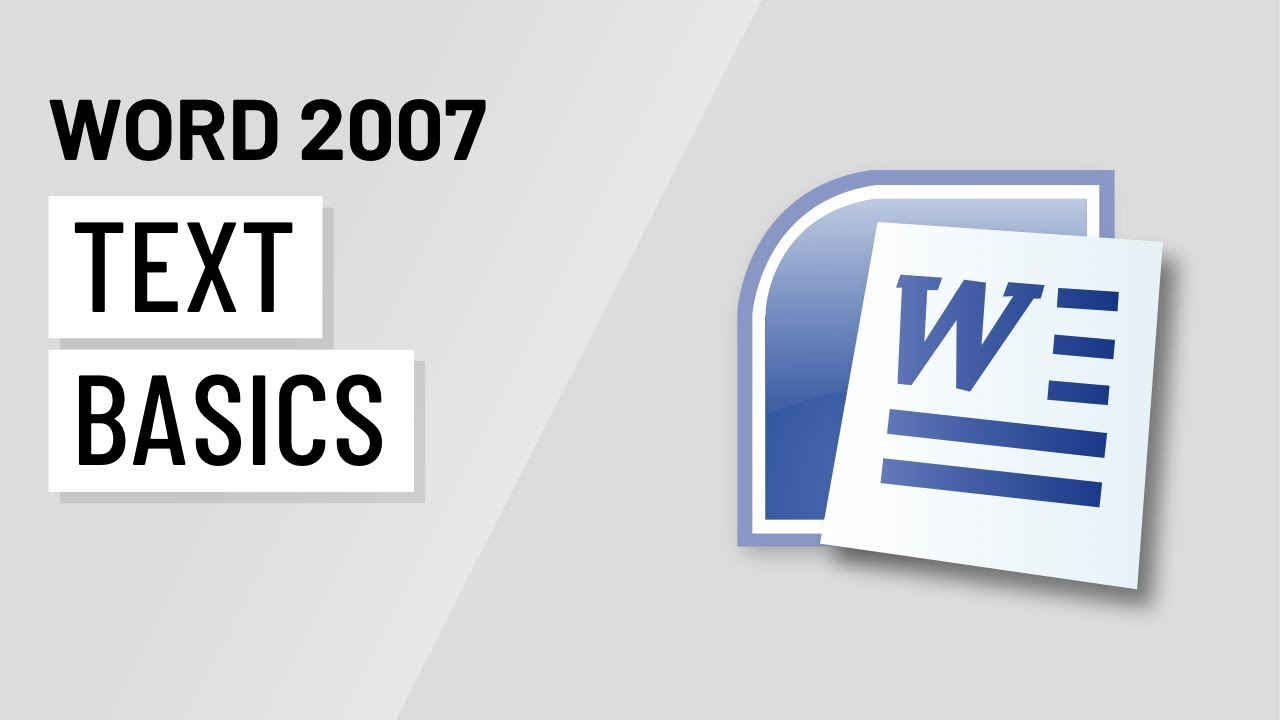
Introduction:
Microsoft Word 2007, a cornerstone of the Microsoft Office suite, introduced a redesigned interface and a host of new features that enhanced document creation and editing. Understanding the basics of working with text in Word 2007 is fundamental for users seeking to create professional and visually appealing documents. This comprehensive guide will explore the essential text basics in Microsoft Word 2007, providing users with the knowledge to efficiently navigate and manipulate text for diverse document needs.
I. Navigating the Word 2007 Interface:
- The Ribbon:
- Word 2007 introduced the Ribbon, a dynamic toolbar that replaced traditional menus. It organizes commands into tabs and groups, streamlining the user interface.
- Quick Access Toolbar:
- Located above the Ribbon, the Quick Access Toolbar provides one-click access to frequently used commands, offering a personalized toolset.
- Document Area:
- The main area where users create and edit content is the document area, where text, images, and other elements are added.
II. Creating and Editing Text:
- Typing and Entering Text:
- Click within the document area and start typing to enter text. Press “Enter” to start a new paragraph.
- Navigating with Arrow Keys:
- Use the arrow keys to navigate through the text. Combine them with the “Ctrl” key to move more quickly.
- Inserting Special Characters:
- Access special characters through the “Insert” tab on the Ribbon to include symbols, equations, or other non-standard characters in your document.
III. Formatting Text:
- Font Styles:
- Modify the font style, size, and color using the options in the Font group on the Home tab of the Ribbon.
- Bold, Italic, Underline:
- Apply bold, italic, and underline formatting using the corresponding buttons in the Font group.
- Text Alignment:
- Align text left, center, right, or justify it using the alignment options in the Paragraph group on the Home tab.
- Line and Paragraph Spacing:
- Adjust line spacing and paragraph spacing to enhance readability and document aesthetics.
IV. Lists and Bullets:
- Creating Bulleted Lists:
- Use the Bullets button in the Paragraph group to create bulleted lists. Customize the bullet style as needed.
- Numbered Lists:
- Utilize the Numbering button to create numbered lists with various formatting options.
V. Paragraph Formatting:
- Indentation:
- Adjust indentation for paragraphs to control the document’s structure and visual hierarchy.
- Borders and Shading:
- Enhance the appearance of text and paragraphs by adding borders and shading through the Borders and Shading dialog box.
VI. Styles and Themes:
- Applying Styles:
- Utilize predefined styles from the Styles group on the Home tab to quickly format text consistently.
- Themes:
- Explore document themes in Word 2007 to apply coordinated font sets, colors, and effects for a professional and unified look.
VII. Spell Check and Proofing:
- Spell Check:
- Run the built-in spell check feature under the Review tab to identify and correct spelling errors.
- Grammar Check:
- Use the grammar check feature to identify and correct grammatical errors in your document.
VIII. Find and Replace:
- Locating Text:
- The Find feature, accessible through the Home tab, allows users to locate specific text within the document.
- Replacing Text:
- Replace specific instances of text using the Replace feature, streamlining document-wide changes.
IX. Working with Headers and Footers:
- Inserting Headers and Footers:
- Access the Insert tab to add headers and footers to your document for page numbering, document titles, and other information.
- Page Numbers:
- Customize page numbers and their placement using the Page Number feature in the Header & Footer group.
X. Saving and Exporting:
- Saving Documents:
- Save your document using the Save button or “Ctrl + S.” Choose a location, provide a filename, and select the desired format (e.g., .docx).
- Exporting Documents:
- Export your document to different formats using the “Save As” option, allowing compatibility with various software and platforms.
XI. Printing Documents:
- Print Preview:
- Use the Print Preview feature to review how your document will appear when printed.
- Print Options:
- Access the Print options to configure settings such as page orientation, paper size, and number of copies.
XII. Collaboration and Comments:
- Inserting Comments:
- Collaborate with others by inserting comments. Use the Review tab to manage and respond to comments.
- Tracking Changes:
- Enable Track Changes to monitor and accept/reject edits made by collaborators during the review process.
XIII. Document Properties:
- Setting Document Properties:
- Access document properties, such as title, author, and keywords, through the Document Information Panel under the Office button.
- Document Properties in File Explorer:
- View and edit document properties directly from File Explorer for efficient document management.
XIV. Mastering Text Basics:
- Practice and Exploration:
- Mastering text basics in Word 2007 requires practice and exploration. Experiment with different features to discover their full potential.
- Online Resources and Tutorials:
- Explore online resources, tutorials, and Microsoft’s official documentation for continuous learning and staying updated on new features.
Conclusion:
Understanding the basics of working with text in Microsoft Word 2007 is essential for creating polished and professional documents. By mastering the features outlined in this comprehensive guide, users can efficiently navigate the Word 2007 interface, format text, collaborate with others, and produce documents that meet the highest standards of clarity and visual appeal. As you integrate these text basics into your workflow, you’ll unlock the full potential of Microsoft Word 2007 for document creation and editing.